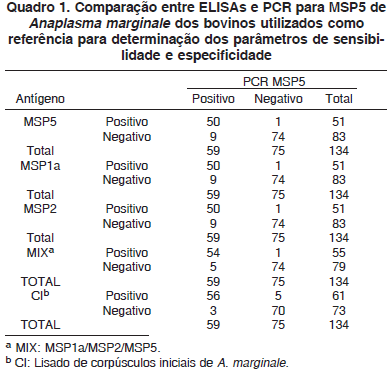Bovine anaplasmosis is a major disease in tropical and subtropical regions of the world by determine economical loss due mortality and productive reduction. The disease is caused by Anaplasma marginale, an intraerythrocytic rickettsia whose control requires, besides an efficient vaccine, the accurate identification of chronically infected cattle. Although the existence of diverse methods of diagnosis of this rickettsia, the serological methods, in particular the enzyme immunosorbent assays (ELISAs), are the most used due to its versatility and practice. However, due to the high number of antigens currently available, an evaluation becomes necessary to define which antigens present the better performance in the diagnosis of anaplasmosis. Sera from cattle positive or negative to A. marginale by PCR, and sera from cattle proceeding from Brazil and Costa Rica, were tested by ELISAs based in recombinant MSP1a, MSP2, and MSP5, a pool of the three recombinant proteins, and initial body lisate antigen (CI). Using sera from A. marginale positive cattle by PCR, the highest sensitivity was shown by CI ELISA. Nevertheless, the highest specificity, with sera from negative cattle by PCR, was shown by recombinants ELISAs. The percentiles of positive cattle from Brazil and Costa Rica were higher with CI ELISA. Reasons for such differences were discussed.
Anaplasma marginale; ELISA; recombinant proteins; antigens



